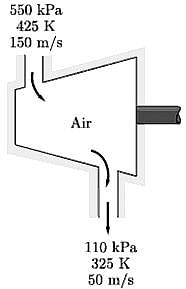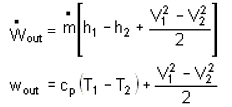Mechanical Engineering Exam > Mechanical Engineering Questions > In an adiabatic turbine, air enters at 550 kP...
Start Learning for Free
In an adiabatic turbine, air enters at 550 kPa, 425K and leaves at 110 kPa, 325 K. The inlet and exit velocities of the air are 150 m/s and 50 m/s, respectively. The air properties are cp = 1.011 kJ/kg−K and R = 0.287 kJ/kg−K. Use T0 = 25°C.
What will be the actual work in (kJ/kg)? (Answer up to the nearest integer)
Correct answer is '111'. Can you explain this answer?
| FREE This question is part of | Download PDF Attempt this Test |
Most Upvoted Answer
In an adiabatic turbine, air enters at 550 kPa, 425K and leaves at 110...

The energy balance for this steady-flow system can be expressed in the rate form as




Attention Mechanical Engineering Students!
To make sure you are not studying endlessly, EduRev has designed Mechanical Engineering study material, with Structured Courses, Videos, & Test Series. Plus get personalized analysis, doubt solving and improvement plans to achieve a great score in Mechanical Engineering.

|
Explore Courses for Mechanical Engineering exam
|

|
Similar Mechanical Engineering Doubts
In an adiabatic turbine, air enters at 550 kPa, 425K and leaves at 110 kPa, 325 K. The inlet and exit velocities of the air are 150 m/s and 50 m/s, respectively. The air properties are cp = 1.011 kJ/kg−K and R = 0.287 kJ/kg−K. Use T0 = 25°C.What will be the actual work in (kJ/kg)? (Answer up to the nearest integer)Correct answer is '111'. Can you explain this answer?
Question Description
In an adiabatic turbine, air enters at 550 kPa, 425K and leaves at 110 kPa, 325 K. The inlet and exit velocities of the air are 150 m/s and 50 m/s, respectively. The air properties are cp = 1.011 kJ/kg−K and R = 0.287 kJ/kg−K. Use T0 = 25°C.What will be the actual work in (kJ/kg)? (Answer up to the nearest integer)Correct answer is '111'. Can you explain this answer? for Mechanical Engineering 2024 is part of Mechanical Engineering preparation. The Question and answers have been prepared according to the Mechanical Engineering exam syllabus. Information about In an adiabatic turbine, air enters at 550 kPa, 425K and leaves at 110 kPa, 325 K. The inlet and exit velocities of the air are 150 m/s and 50 m/s, respectively. The air properties are cp = 1.011 kJ/kg−K and R = 0.287 kJ/kg−K. Use T0 = 25°C.What will be the actual work in (kJ/kg)? (Answer up to the nearest integer)Correct answer is '111'. Can you explain this answer? covers all topics & solutions for Mechanical Engineering 2024 Exam. Find important definitions, questions, meanings, examples, exercises and tests below for In an adiabatic turbine, air enters at 550 kPa, 425K and leaves at 110 kPa, 325 K. The inlet and exit velocities of the air are 150 m/s and 50 m/s, respectively. The air properties are cp = 1.011 kJ/kg−K and R = 0.287 kJ/kg−K. Use T0 = 25°C.What will be the actual work in (kJ/kg)? (Answer up to the nearest integer)Correct answer is '111'. Can you explain this answer?.
In an adiabatic turbine, air enters at 550 kPa, 425K and leaves at 110 kPa, 325 K. The inlet and exit velocities of the air are 150 m/s and 50 m/s, respectively. The air properties are cp = 1.011 kJ/kg−K and R = 0.287 kJ/kg−K. Use T0 = 25°C.What will be the actual work in (kJ/kg)? (Answer up to the nearest integer)Correct answer is '111'. Can you explain this answer? for Mechanical Engineering 2024 is part of Mechanical Engineering preparation. The Question and answers have been prepared according to the Mechanical Engineering exam syllabus. Information about In an adiabatic turbine, air enters at 550 kPa, 425K and leaves at 110 kPa, 325 K. The inlet and exit velocities of the air are 150 m/s and 50 m/s, respectively. The air properties are cp = 1.011 kJ/kg−K and R = 0.287 kJ/kg−K. Use T0 = 25°C.What will be the actual work in (kJ/kg)? (Answer up to the nearest integer)Correct answer is '111'. Can you explain this answer? covers all topics & solutions for Mechanical Engineering 2024 Exam. Find important definitions, questions, meanings, examples, exercises and tests below for In an adiabatic turbine, air enters at 550 kPa, 425K and leaves at 110 kPa, 325 K. The inlet and exit velocities of the air are 150 m/s and 50 m/s, respectively. The air properties are cp = 1.011 kJ/kg−K and R = 0.287 kJ/kg−K. Use T0 = 25°C.What will be the actual work in (kJ/kg)? (Answer up to the nearest integer)Correct answer is '111'. Can you explain this answer?.
Solutions for In an adiabatic turbine, air enters at 550 kPa, 425K and leaves at 110 kPa, 325 K. The inlet and exit velocities of the air are 150 m/s and 50 m/s, respectively. The air properties are cp = 1.011 kJ/kg−K and R = 0.287 kJ/kg−K. Use T0 = 25°C.What will be the actual work in (kJ/kg)? (Answer up to the nearest integer)Correct answer is '111'. Can you explain this answer? in English & in Hindi are available as part of our courses for Mechanical Engineering.
Download more important topics, notes, lectures and mock test series for Mechanical Engineering Exam by signing up for free.
Here you can find the meaning of In an adiabatic turbine, air enters at 550 kPa, 425K and leaves at 110 kPa, 325 K. The inlet and exit velocities of the air are 150 m/s and 50 m/s, respectively. The air properties are cp = 1.011 kJ/kg−K and R = 0.287 kJ/kg−K. Use T0 = 25°C.What will be the actual work in (kJ/kg)? (Answer up to the nearest integer)Correct answer is '111'. Can you explain this answer? defined & explained in the simplest way possible. Besides giving the explanation of
In an adiabatic turbine, air enters at 550 kPa, 425K and leaves at 110 kPa, 325 K. The inlet and exit velocities of the air are 150 m/s and 50 m/s, respectively. The air properties are cp = 1.011 kJ/kg−K and R = 0.287 kJ/kg−K. Use T0 = 25°C.What will be the actual work in (kJ/kg)? (Answer up to the nearest integer)Correct answer is '111'. Can you explain this answer?, a detailed solution for In an adiabatic turbine, air enters at 550 kPa, 425K and leaves at 110 kPa, 325 K. The inlet and exit velocities of the air are 150 m/s and 50 m/s, respectively. The air properties are cp = 1.011 kJ/kg−K and R = 0.287 kJ/kg−K. Use T0 = 25°C.What will be the actual work in (kJ/kg)? (Answer up to the nearest integer)Correct answer is '111'. Can you explain this answer? has been provided alongside types of In an adiabatic turbine, air enters at 550 kPa, 425K and leaves at 110 kPa, 325 K. The inlet and exit velocities of the air are 150 m/s and 50 m/s, respectively. The air properties are cp = 1.011 kJ/kg−K and R = 0.287 kJ/kg−K. Use T0 = 25°C.What will be the actual work in (kJ/kg)? (Answer up to the nearest integer)Correct answer is '111'. Can you explain this answer? theory, EduRev gives you an
ample number of questions to practice In an adiabatic turbine, air enters at 550 kPa, 425K and leaves at 110 kPa, 325 K. The inlet and exit velocities of the air are 150 m/s and 50 m/s, respectively. The air properties are cp = 1.011 kJ/kg−K and R = 0.287 kJ/kg−K. Use T0 = 25°C.What will be the actual work in (kJ/kg)? (Answer up to the nearest integer)Correct answer is '111'. Can you explain this answer? tests, examples and also practice Mechanical Engineering tests.

|
Explore Courses for Mechanical Engineering exam
|

|
Suggested Free Tests
Signup for Free!
Signup to see your scores go up within 7 days! Learn & Practice with 1000+ FREE Notes, Videos & Tests.
























